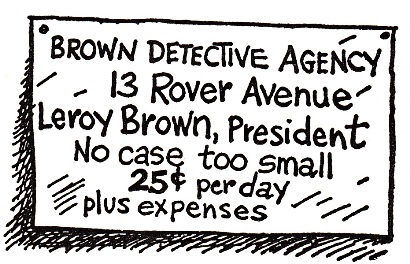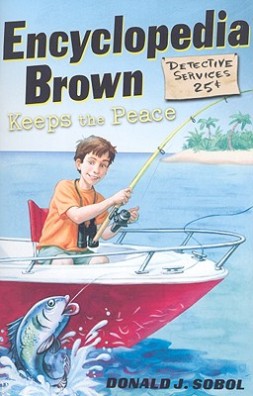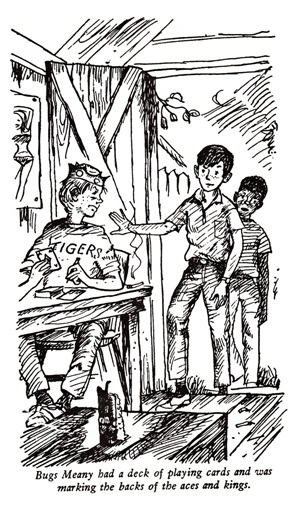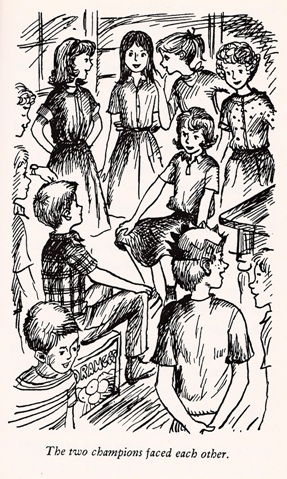My wife has been having a lot of fun recently reading some older chapter books with our daughter at bedtime (Lulu and the Brontosaurus, The Tale of Despereaux, Roald Dahl’s The Witches), and, I’ll admit, I’ve been stone-cold jealous. My few recent attempts to read longer works with our daughter have failed rather spectacularly, either degenerating into her telling me how much she dislikes “black and white only” books or with her working herself up into a frenzy because “Harry Potter is too scary for me, Dad! Don’t! DO NOT read it to me!!” (In my own defense, I’d barely lifted The Sorcerer’s Stone off the shelf before the freak-out commenced.) I love reading picture books and beginning readers with her, but I was anxious to see her reaction to being exposed to slightly longer, slightly more mature reading material. Plus she sat and listed quietly for her mom, so it’s not fair. (Crosses arms and pouts.)
My salvation ended up coming from an extremely nostalgic place for me – Donald J. Sobol’s Encyclopedia Brown series.
When I was a kid, our home library didn’t have a FRACTION of the books that my daughter has available to her every day. We used our local library a lot and I only have a vague recollection of a few specific books that we actually owned ourselves. (Just FYI – I have a notoriously lousy memory.) I remember our house having copies of The Giving Tree, Dr. Seuss’ Butter Battle Book, Alexander and the Terrible, Horrible, No-Good, Very Bad Day, a metric ton of “Choose Your Own Adventure” books, and an almost complete collection of Encyclopedia Brown mysteries.

This might sound odd, but the illustration of this sign is easily one of the most iconic images from my childhood...
I picked up a copy of Encyclopedia Brown Keeps the Peace, volume six of Sobol’s original series, while on a family vacation two weeks ago and got almost giddy with nostalgia and long-forgotten memories as I flipped through the collection. Encyclopedia Brown gets mocked a lot in popular culture – getting jabbed at in everything from possibly my favorite Onion article ever to the fantastic cult comedy, Mystery Team, by Donald Glover and Derrick Comedy – BUT I legitimately, totally, and unironically love and respect the Encyclopedia Brown mysteries.
I think some people dismiss Donald Sobol as formulaic, which I understand, but give the man his due for creating a really wonderful formula. Sobol PERFECTED the procedural mystery for early readers. The “procedural mystery” is an incredibly powerful storytelling format, which has dominated television programming for years now in shows like CSI, NCIS, Castle, Psych, Law & Order, and House, among many others. People find comfort and structure in the procedural mystery. The stories are quick, detail-packed, and normally engaging since the reader will spend the duration of the tale wondering “whodunit”. And, if you have really great writers, you can tell some amazing stories in the procedural mystery format too.
I actually think Sobol is a great writer, and his mysteries are perfectly structured for early readers with potentially short attention spans. He uses recurring characters to make the reader empathize with his cast, he tells his stories in quick 6 to 10 page bursts, and he even gives his young readers a physical activity – flipping to the back of the book to read the solution to the mystery – to keep their interests.
Yes, Leroy Brown solves crimes WAY too easily and most of his cases can be cracked thanks to his obsessive knowledge of odd bits of obscure trivia. (“That sword isn’t from the Civil War! If it was, why would the inscription read the FIRST Battle of Bull Run… yadda, yadda, yadda.”) But, given the age of his target audience, I think all those are moot points. Sobol wasn’t trying to be Agatha Christie. He was making creative problem solving entertaining for kids through a nice mixture of relatable characters and the tried-and-true mystery format.
And, yes, the Encyclopedia Brown collections are fairly repetitive – but so is most series’ fiction. I think the constant, continually rebooting world of Brown’s hometown of Idaville is a welcoming, familiar place for young readers. Kids know how the world works in Idaville and, when reading an Encyclopedia Brown mystery, they’re using their aggregated past knowledge of how Sobol’s procedurals traditionally work to see if they can mentally jump to the solution hidden at the end of the book before they physically have to turn the pages and see if they’re right. In my opinion, it’s a really winning formula that encourages kids to be active, questioning readers and I don’t think Sobol gets enough credit for the simplicity and elegance of the Encyclopedia Brown format.
Now it did fully occur to me that my reverence for Encyclopedia Brown could very well just be a byproduct of several decades’ worth of nostalgia catching up with me, but two things confirmed for me that my impressions of Sobol’s mysteries weren’t just my inner-child looking backwards with rose-colored glasses.
First and foremost, my daughter LOVED Encyclopedia Brown Keeps the Peace. Loved it. She immediately perked up to the concept of a kid detective – at one point, she said, “I think it’s nice that his policeman daddy asks for his help like he was a grown-up.” Leroy Brown warrants a very adult-level of respect from the citizens of Idaville, and my daughter really responded to that. She appreciated how Encyclopedia thoughtfully solved crimes – “That was a really smart idea he had, Dad” – but she adored how much value everyone in Idaville placed in his opinions.
I’d planned to read just the first mystery to my daughter to see what she thought, but, after excitedly demanding that I race to the back of the book to read her “The Solution to the Case of the Silver Fruit Bowl,” she begged me to read more and we got through another five mysteries before I finally insisted that it was bedtime. The next morning, she wanted to talk through all the solutions again, and she also let me know how much she really enjoyed the recurring characters. My daughter has a sick fascination with the “bully” archetype –she often makes me pretend that I’m a bully teasing her, if only so she can beat me at whatever game we’re playing and say “Ha, ha, take that, bully!” – so the character of Bugs Meany, Leroy’s eternal nemesis, became a quick favorite.
But the character that my daughter REALLY went nuts for was Sally Kimball, Encyclopedia Brown’s partner and the toughest girl in town. I’d almost forgotten Sally’s role as the enforcer in the Brown mysteries, but, as soon as I described her role in the stories, my daughter’s eyes went HUGE and she instantly fell in love. “Wait,” she said, “She can beat up ANY boy in town? Even the bullies?” When I confirmed this for her, she demanded that I show her a picture of Sally. I quickly turned to one of illustrator Leonard Shortall’s pictures of Sally and my daughter, again, swooned. “She’s so pretty. And she can still beat up all those boys? I love her! Can we play Sally tomorrow?”
While there’s a part of me that probably should be concerned that my daughter became so enamored with a character just because she was good at beating people up, I do think Sally is a wonderfully atypical female character that brings an added layer of depth to the Brown mysteries for young girls. Yes, Sally is always the Watson to Leroy’s Sherlock, and she’s rarely allowed to contribute much to the cases intellectually – though she does help Brown narrow down his options through debate – but it is so unusual to have a young female character be the dominant physical presence in a juvenile adventure story that, for once, I’m glad that a character is known for her brawn over her brains.
And the best part is that Sobol doesn’t try to make Sally seem unusual or unseemly for being such a powerhouse. She’s well-spoken and smart. She’s never made to seem overly butch or un-feminine. Shortall’s illustrations of Sally, in particular, could’ve turned her either into a roided-out masculine she-monster or a sexed-up athletic type, but instead, Sally is shown to be ridiculously and refreshingly normal. She looks like any other girl, except that we know, through the text, that she could destroy any bully in town, and I think that’s why, after only a few pages, my five-year-old daughter just thought she was unspeakably cool.
(The story of how Sally became Encyclopedia Brown’s partner in “The Case of Merko’s Grandson” in the very first Brown mystery collection, Encyclopedia Brown, Boy Detective. In that story, the new-in-town Sally challenges Leroy to a battle of the wits after she proves herself to be tough by cleaning the floor with Bugs Meany. She loses the contest – it was close – and, in the very next story, Encyclopedia makes her his bodyguard and junior partner.)
And the second thing that made me realize that my affection for the Encyclopedia Brown books wasn’t just a nostalgic delusion was, while re-reading the mysteries, realizing what a clever, intelligent writer Sobol could be. I wasn’t really expecting this, but there were lines in Encyclopedia Brown Keeps the Peace that made me laugh out loud. It was mostly just little turns of phrases. Things like the way Sobol would play with words, like how he opened “The Case of the Cave Drawings” with “Elmer Evans came into the Brown Detective Agency. He was breathing.” Or the way that he described Bugs Meany’s gang, The Tigers – “They should’ve called themselves the Tea Bags. They were always getting into hot water.” Occasionally, some of his asides and references come off as a little dated and anachronistic, but, for the most part, Sobol’s text is well composed, smart, and fun to read.
So, nostalgia be damned, the Encyclopedia Brown mysteries are fantastic, engaging, and quick reads that, I think, are perfect for any kid who is starting to show interest in moving beyond easy readers, but perhaps isn’t quite ready for full chapter books yet. Plus they really do show off what a powerful format the mystery can be for making young readers get excited about reading. But, all that aside, all I know is that I finally – FINALLY – have my very own almost-chapter books that I can read aloud with my daughter and that fact that she’s so enjoying a series of books that was so important to me in my youth – well, that just makes it all the more sweeter.
WHY WAS THE FATHER SUCH A NOSTALGIC WUSS?
(Turn to page 84 for the solution to The Case of the Emasculated Dad.)
THE DETAILS ON ENCYCLOPEDIA BROWN KEEPS THE PEACE
AGE RANGE: The stated age range is 7 and up, but it’ll be up to you whether your kid is ready for Encyclopedia Brown at an earlier age. After reading through a few of the mysteries, I was very comfortable reading them to our 5-year-old – while the “whodunit” aspect gives the stories their tension, the characters never really appear to be in any danger. Idaville is a very safe place for young readers – however, the stories do occasionally reference guns and things liked armed robberies, so, if that subject matter is particularly troublesome for your kid, you might want to wait a few more years.
PAGE COUNT: 96 pages (the page count of the 13 original Sobol mysteries varies per volume)
RELATED WEB SITES: You can find the official Penguin page for Encyclopedia Brown Keeps the Peace here, but it doesn’t have much information. Actually, for such an iconic series, there’s a real shortage of material on Encyclopedia Brown online. You can hear an audio interview with Donald Sobol here and find a short biography of Sobol here. The Encyclopedia Brown Wikipedia page is probably the best online resource out there currently, which is just sad.
BUY IT, BORROW IT, OR FORGET IT?: I would borrow a Encyclopedia Brown mystery from your library first to see if your kid is into it. There is a very particular vibe to the Brown mysteries – it tiptoes the line between clever and cheesy – and certain kids might not appreciate Sobol’s earnestly Americana tone.
My readalikes for Encyclopedia Brown will be coming soon…




{ 5 comments… read them below or add one }
I just discovered this website by searching for Encyclopedia Brown. I, too, loved the series as a young reader, and revisited the stories over the years. And I agree with your assessment of Mr. Sobol’s writing.
Tom B. and Jessica,
I am Donald Sobol’s daughter. My father would have been so delighted and touched to read your lovely comments about his books. ( I just discovered the comments December 2013 on this website.) Encyclopedia’s friend, Sally was one of the few independent girl-characters who could hold her own. She is based on my father’s sister who is five years old than he. My aunt fearlessly stood up to boys who bullied my father as a young boy. My father passed away in 2012. Thank you for your for taking the time to write and submit the above. Sincerely, Diane Sobol
Diane – Thank you so much for your kind words.
Your father had a such a wonderfully positive impact on my life (and my daughter’s life) through his stories. Encyclopedia Brown meant a lot to me as a child and it’s heartening to see how much Encyclopedia and Sally mean to my own young daughter. I was a tremendous fan of your father’s and will miss him terribly. Thank you again.
Tom
I loved Encyclopedia Brown! I devoured those books as a young reader. I’ll need to get them for my daughter. I think that she will really like them.
I feel your pain with your daughter’s Harry Potter fear. I was so excited to share Roald Dahl with my daughter when she was younger. She was about 5 years old and I started reading James and the Giant Peach to her. She got terrified and screamed, so I stopped reading it and we moved on to another book. A few days later she discovered that I had left the book in her bookcase. She took the book and threw it down the stairs! She couldn’t even have it in the same room with her.
That’s a fantastic story!
My daughter had a similar (though less extreme) reaction when my wife started reading her Kate DiCamillo’s The Tale of Despereaux. She was adamant that the story was too scary, too scary, but my wife kept reading a little bit each night, and, despite her objections, she kept listening and listening and very quickly realized that she wanted to know how the story ended. (Knowing our daughter, we could also tell that her claims that the story was “scaring” her was just a big act. She was more antsy than scared.)
My wife just started reading Dahl’s The Witches with my daughter and, unlike with Despereaux, I was legitimately worried that it would scare her. But – and this shocked me – she’s really liking it. Parent deaths? No problem! Evil witches? Big deal. Disappearing children? Who needed them? I officially have no idea what she finds legitimately scary anymore.
You must log in to post a comment.
{ 1 trackback }